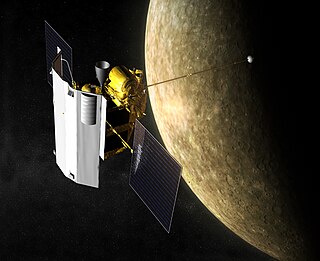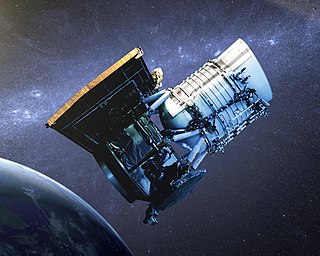
Atmospheric entry is the movement of an object from outer space into and through the gases of an atmosphere of a planet, dwarf planet, or natural satellite. There are two main types of atmospheric entry: uncontrolled entry, such as the entry of astronomical objects, space debris, or bolides; and controlled entry of a spacecraft capable of being navigated or following a predetermined course. Technologies and procedures allowing the controlled atmospheric entry, descent, and landing of spacecraft are collectively termed as EDL.

A trans-lunar injection (TLI) is a propulsive maneuver, which is used to send a spacecraft to the Moon. Typical lunar transfer trajectories approximate Hohmann transfers, although low-energy transfers have also been used in some cases, as with the Hiten probe. For short duration missions without significant perturbations from sources outside the Earth-Moon system, a fast Hohmann transfer is typically more practical.

Aerobraking is a spaceflight maneuver that reduces the high point of an elliptical orbit (apoapsis) by flying the vehicle through the atmosphere at the low point of the orbit (periapsis). The resulting drag slows the spacecraft. Aerobraking is used when a spacecraft requires a low orbit after arriving at a body with an atmosphere, as it requires less fuel than using propulsion to slow down.

Space debris are defunct human-made objects in space – principally in Earth orbit – which no longer serve a useful function. These include derelict spacecraft, mission-related debris, and particularly-numerous in-Earth orbit, fragmentation debris from the breakup of derelict rocket bodies and spacecraft. In addition to derelict human-made objects left in orbit, space debris includes fragments from disintegration, erosion, or collisions; solidified liquids expelled from spacecraft; unburned particles from solid rocket motors; and even paint flecks. Space debris represents a risk to spacecraft.

The Goddard Space Flight Center (GSFC) is a major NASA space research laboratory located approximately 6.5 miles (10.5 km) northeast of Washington, D.C. in Greenbelt, Maryland, United States. Established on May 1, 1959 as NASA's first space flight center, GSFC employs about 10,000 civil servants and contractors. Named for American rocket propulsion pioneer Robert H. Goddard, it is one of ten major NASA field centers. GSFC is partially within the former Goddard census-designated place; it has a Greenbelt mailing address.

The Solar and Heliospheric Observatory (SOHO) is a European Space Agency (ESA) spacecraft built by a European industrial consortium led by Matra Marconi Space that was launched on a Lockheed Martin Atlas IIAS launch vehicle on 2 December 1995, to study the Sun. It has also discovered over 5,000 comets. It began normal operations in May 1996. It is a joint project between the European Space Agency (ESA) and NASA. SOHO was part of the International Solar Terrestrial Physics Program (ISTP). Originally planned as a two-year mission, SOHO continues to operate after over 25 years in space; the mission has been extended until the end of 2025, subject to review and confirmation by ESA's Science Programme Committee.

Gemini 8 was the sixth crewed spaceflight in NASA's Gemini program. It was launched on March 16, 1966, and was the 14th crewed American flight and the 22nd crewed spaceflight overall. The mission conducted the first docking of two spacecraft in orbit, but also suffered the first critical in-space system failure of a U.S. spacecraft which threatened the lives of the astronauts and required an immediate abort of the mission. The crew returned to Earth safely.

New Horizons is an interplanetary space probe launched as a part of NASA's New Frontiers program. Engineered by the Johns Hopkins University Applied Physics Laboratory (APL) and the Southwest Research Institute (SwRI), with a team led by Alan Stern, the spacecraft was launched in 2006 with the primary mission to perform a flyby study of the Pluto system in 2015, and a secondary mission to fly by and study one or more other Kuiper belt objects (KBOs) in the decade to follow, which became a mission to 486958 Arrokoth. It is the fifth space probe to achieve the escape velocity needed to leave the Solar System.

MESSENGER was a NASA robotic space probe that orbited the planet Mercury between 2011 and 2015, studying Mercury's chemical composition, geology, and magnetic field. The name is a backronym for "Mercury Surface, Space Environment, Geochemistry, and Ranging", and a reference to the messenger god Mercury from Roman mythology.

STS-87 was a Space Shuttle mission launched from Launch Complex 39B of the Kennedy Space Center on 19 November 1997. It was the 88th flight of the Space Shuttle and the 24th flight of Columbia. The mission goals were to conduct experiments using the United States Microgravity Payload (USMP-4), conduct two EVAs, and deploy the SPARTAN-201 experiment. This mission marked the first time an EVA was performed from Columbia. EVAs from Columbia were originally planned for STS-5 in 1982 and STS-80 in 1996, but were canceled due to spacesuit and airlock problems, respectively. It also marked the first EVA conducted by a Japanese astronaut, Takao Doi.

Project Gemini was the second United States human spaceflight program to fly. Conducted after the first American manned space program, Project Mercury, while the Apollo program was still in early development, Gemini was conceived in 1961 and concluded in 1966. The Gemini spacecraft carried a two-astronaut crew. Ten Gemini crews and 16 individual astronauts flew low Earth orbit (LEO) missions during 1965 and 1966.
In spaceflight, an orbital maneuver is the use of propulsion systems to change the orbit of a spacecraft. For spacecraft far from Earth an orbital maneuver is called a deep-space maneuver (DSM).

The Hiten spacecraft, given the English name Celestial Maiden and known before launch as MUSES-A, part of the MUSES Program, was built by the Institute of Space and Astronautical Science of Japan and launched on January 24, 1990. It was Japan's first lunar probe, the first robotic lunar probe since the Soviet Union's Luna 24 in 1976, and the first lunar probe launched by a country other than the Soviet Union or the United States. The spacecraft was named after flying heavenly beings in Buddhism.

Wide-field Infrared Survey Explorer is a NASA infrared astronomy space telescope in the Explorers Program launched in December 2009. WISE discovered thousands of minor planets and numerous star clusters. Its observations also supported the discovery of the first Y-type brown dwarf and Earth trojan asteroid. WISE performed an all-sky astronomical survey with images in 3.4, 4.6, 12 and 22 μm wavelength range bands, over ten months using a 40 cm (16 in) diameter infrared telescope in Earth orbit.

The Magnetospheric Multiscale (MMS) Mission is a NASA robotic space mission to study the Earth's magnetosphere, using four identical spacecraft flying in a tetrahedral formation. The spacecraft were launched on 13 March 2015 at 02:44 UTC. The mission is designed to gather information about the microphysics of magnetic reconnection, energetic particle acceleration, and turbulence — processes that occur in many astrophysical plasmas. As of March 2020, the MMS spacecraft have enough fuel to remain operational until 2040.

The National Aeronautics and Space Administration is an independent agency of the U.S. federal government responsible for the civil space program, aeronautics research, and space research. Established in 1958, it succeeded the National Advisory Committee for Aeronautics (NACA) to give the U.S. space development effort a distinctly civilian orientation, emphasizing peaceful applications in space science. It has since led most American space exploration, including Project Mercury, Project Gemini, the 1968–1972 Apollo Moon landing missions, the Skylab space station, and the Space Shuttle. It currently supports the International Space Station and oversees the development of the Orion spacecraft and the Space Launch System for the crewed lunar Artemis program, the Commercial Crew spacecraft, and the planned Lunar Gateway space station.

Docking and berthing of spacecraft is the joining of two space vehicles. This connection can be temporary, or partially permanent such as for space station modules.

The NASA Launch Services Program (LSP) is responsible for procurement of launch services for NASA uncrewed missions and oversight of launch integration and launch preparation activity, providing added quality and mission assurance to meet program objectives. LSP operates under the NASA Space Operations Mission Directorate (SOMD).
A distant retrograde orbit (DRO), as most commonly conceived, is a spacecraft orbit around a moon that is highly stable because of its interactions with two Lagrange points (L1 and L2) of the planet–moon system.
NASA's Solar Terrestrial Probes program (STP) is a series of missions focused on studying the Sun-Earth system. It is part of NASA's Heliophysics Science Division within the Science Mission Directorate.

















